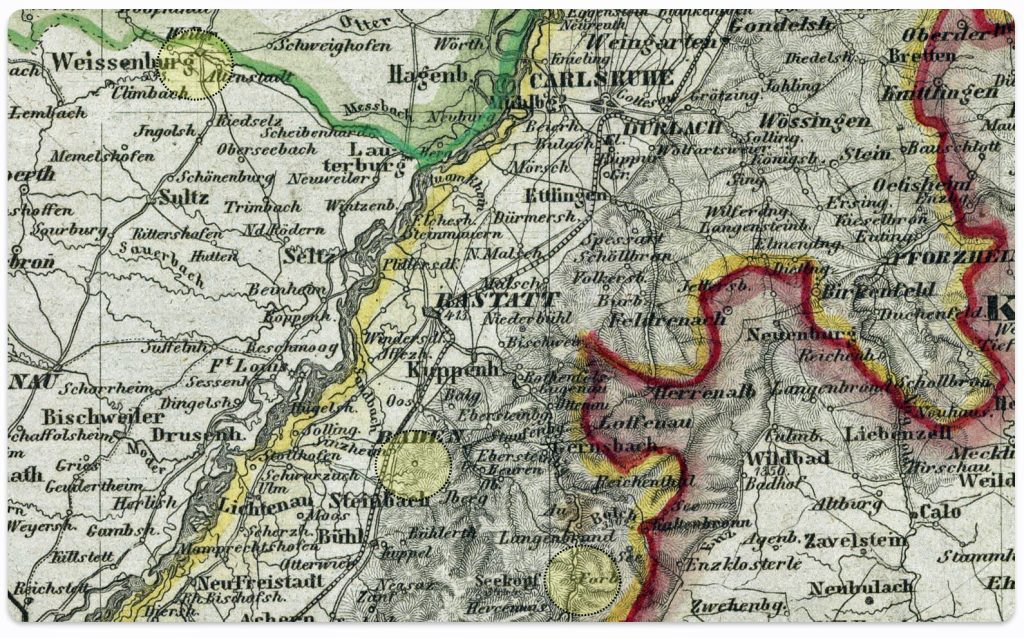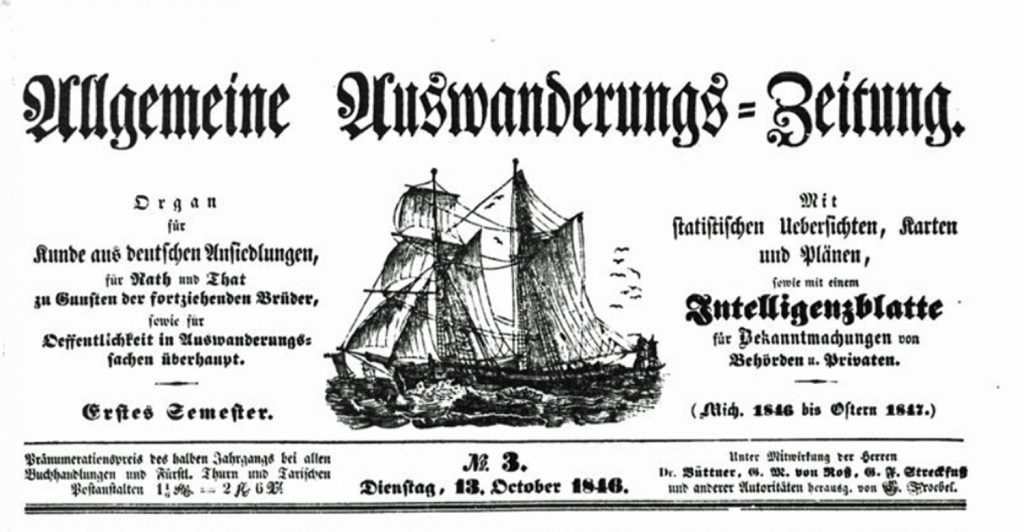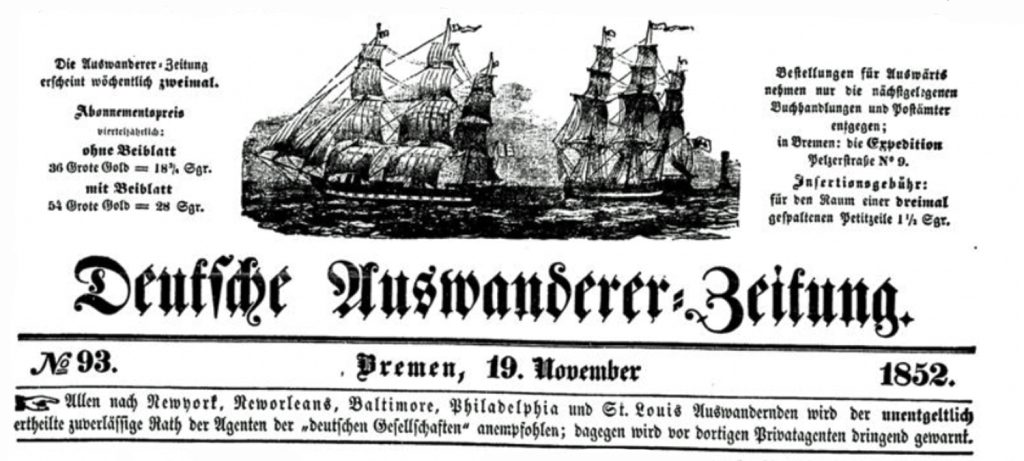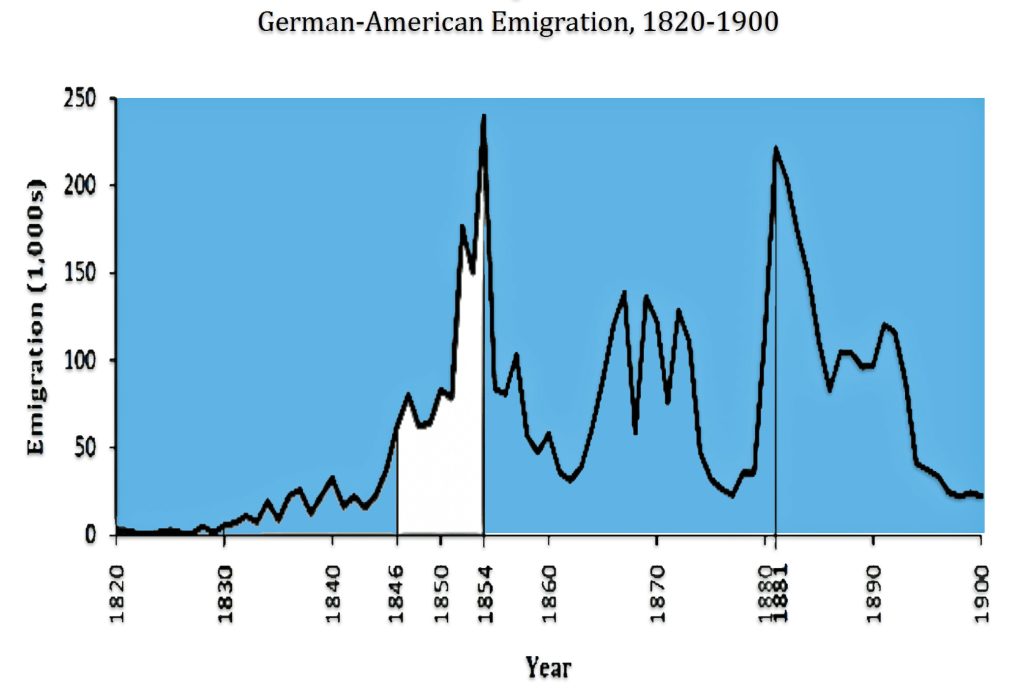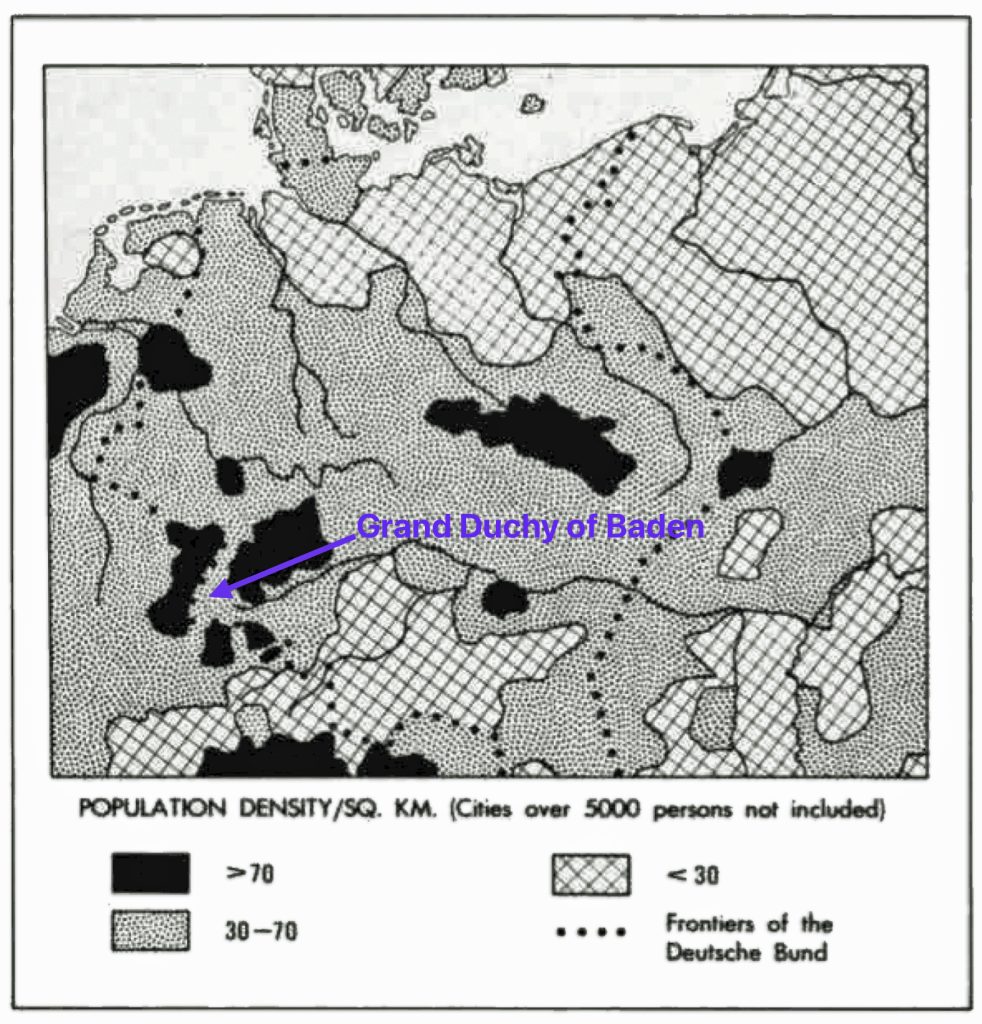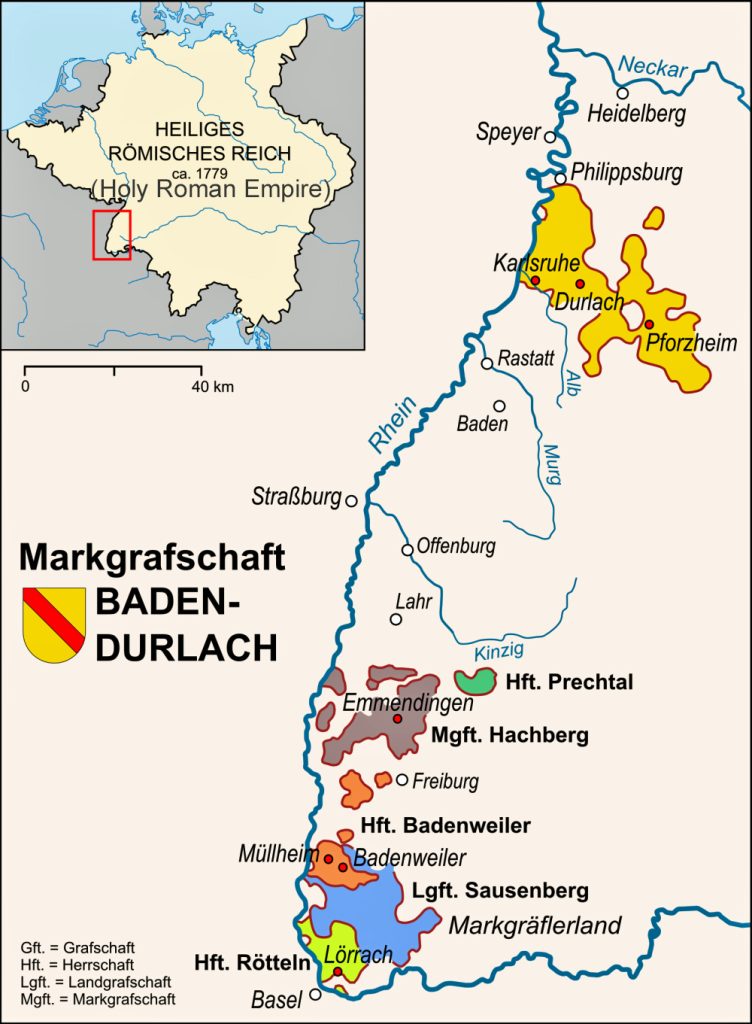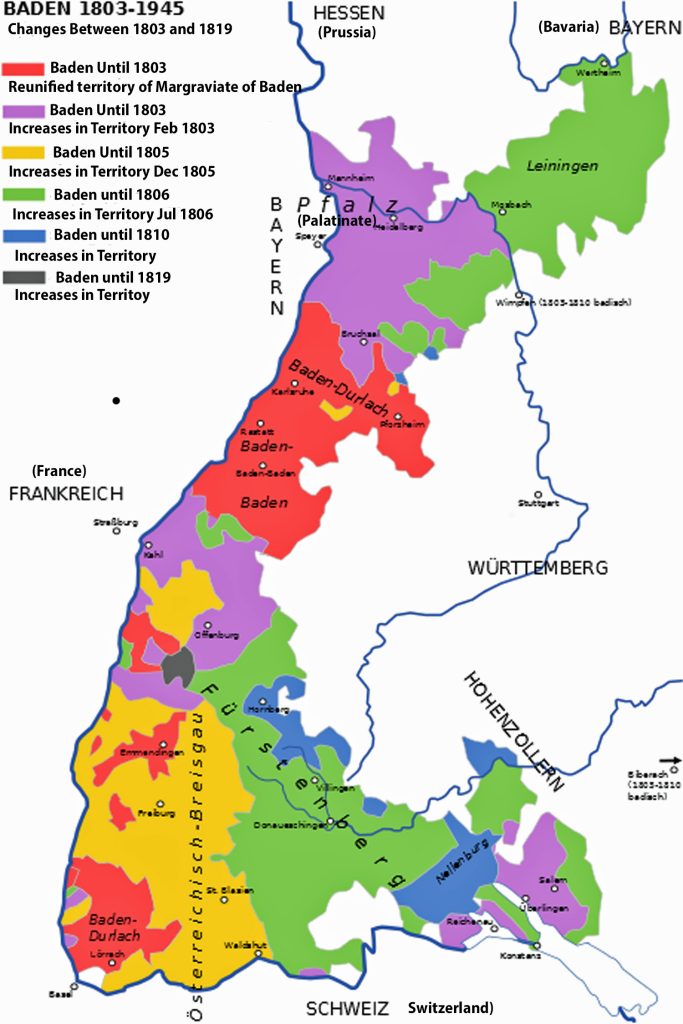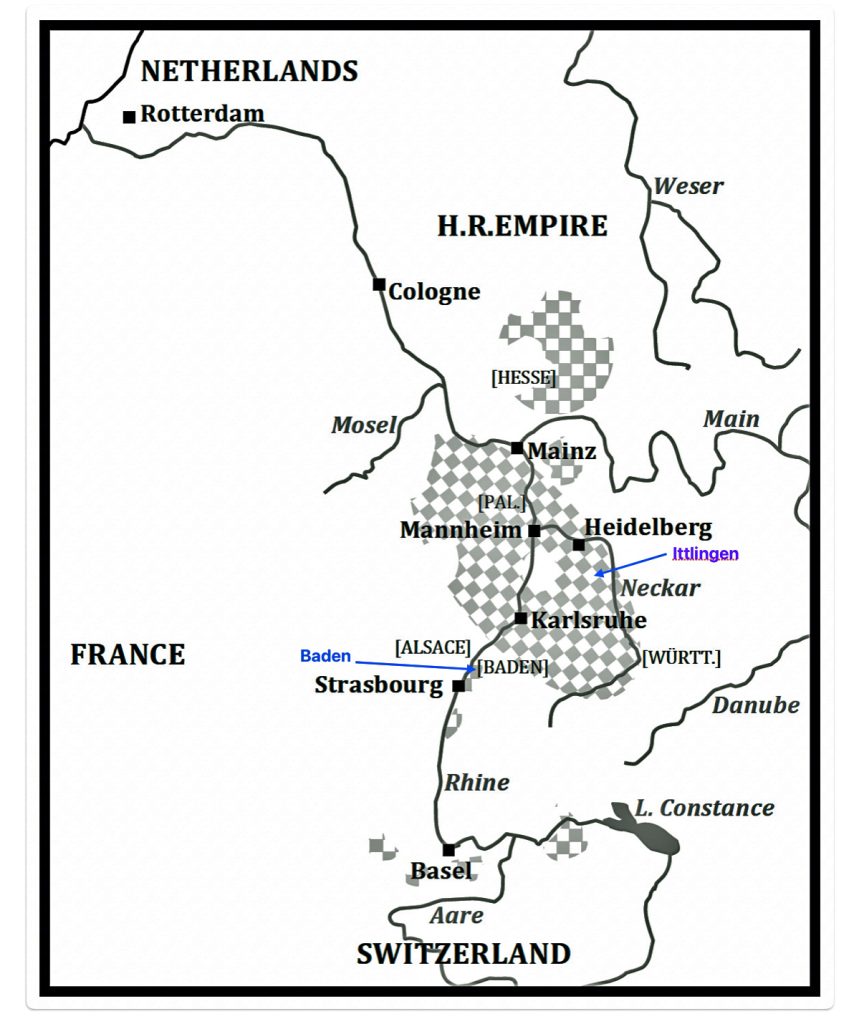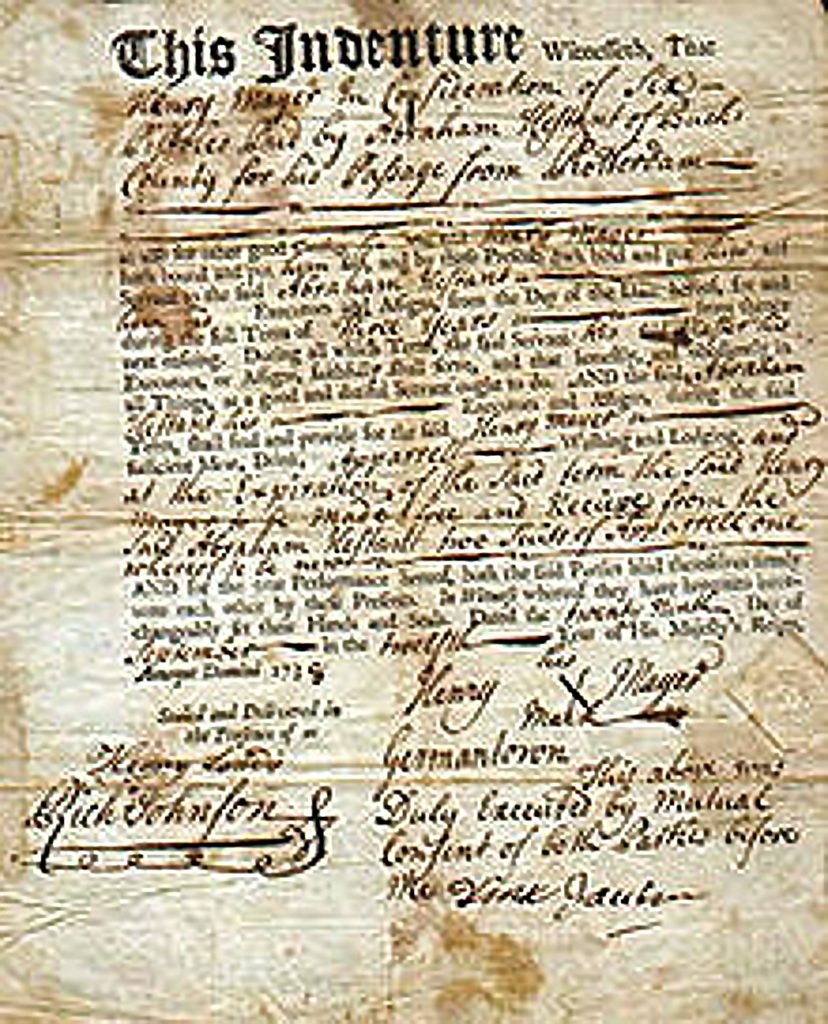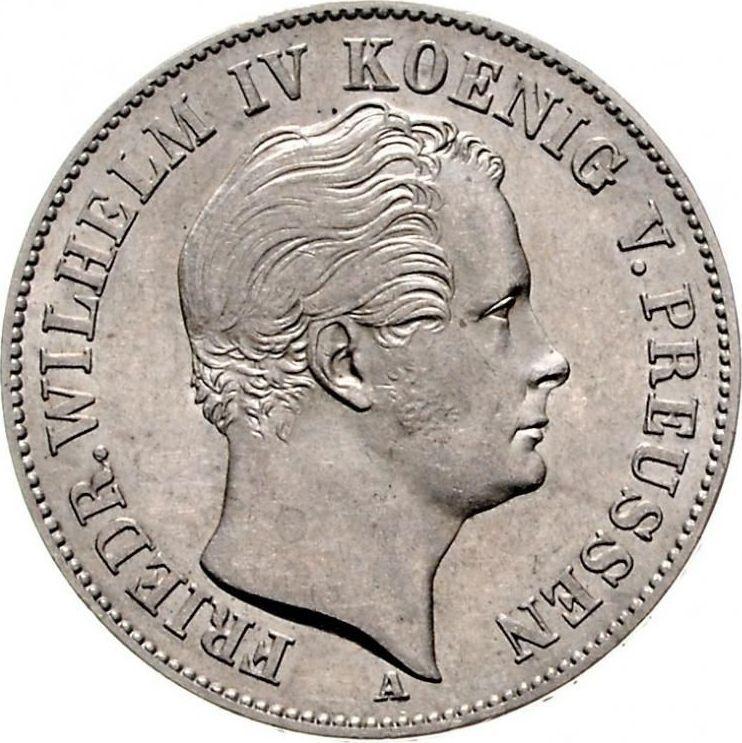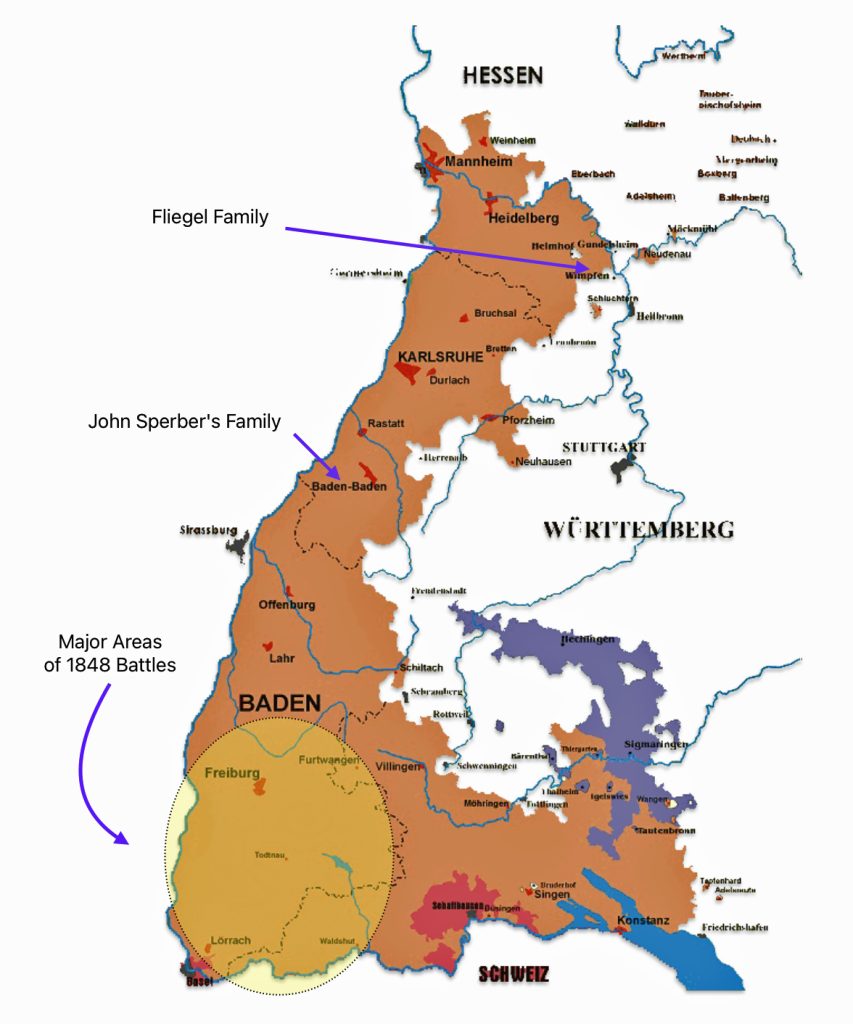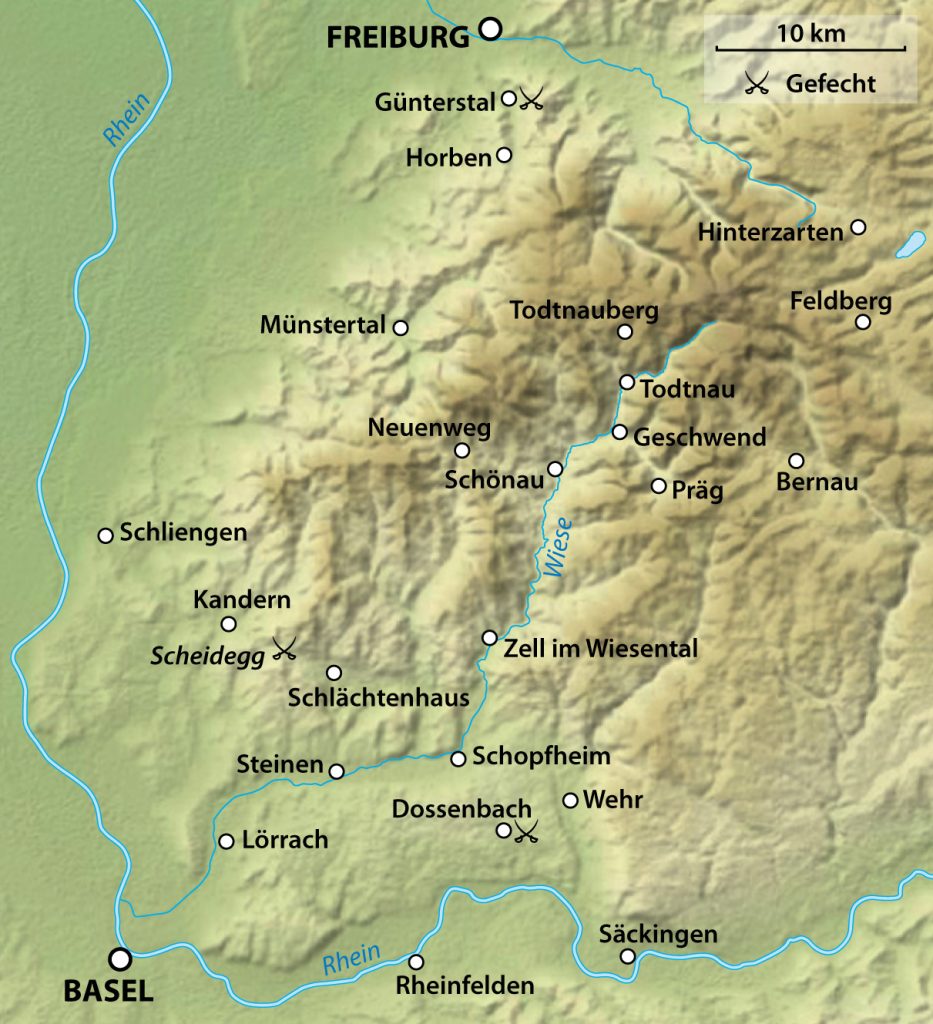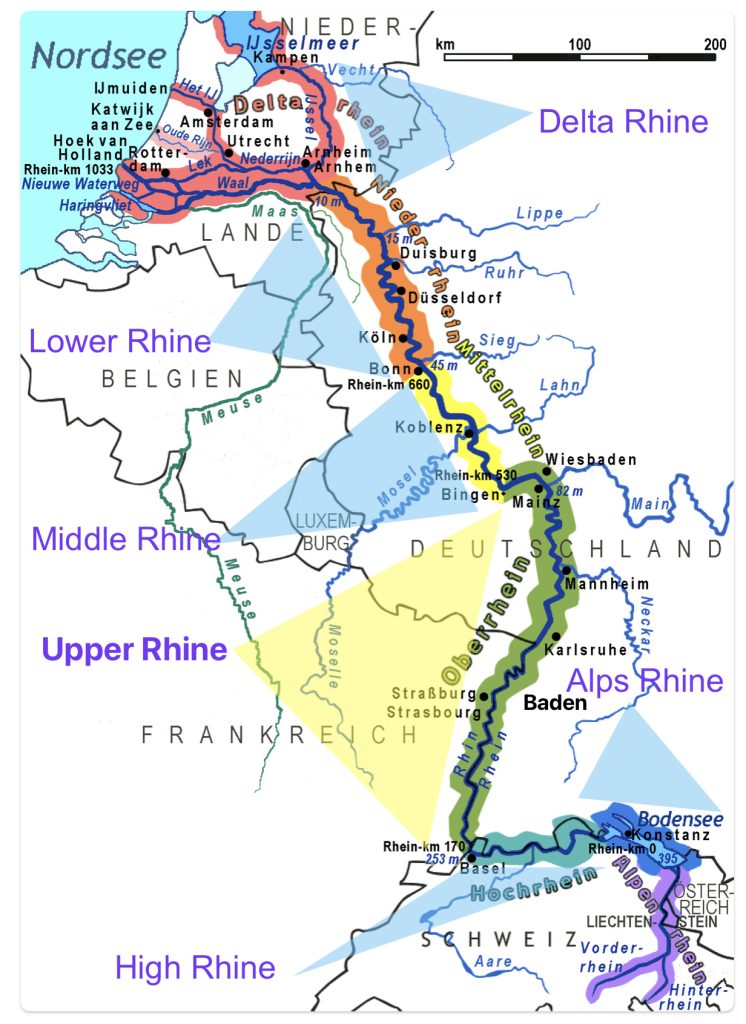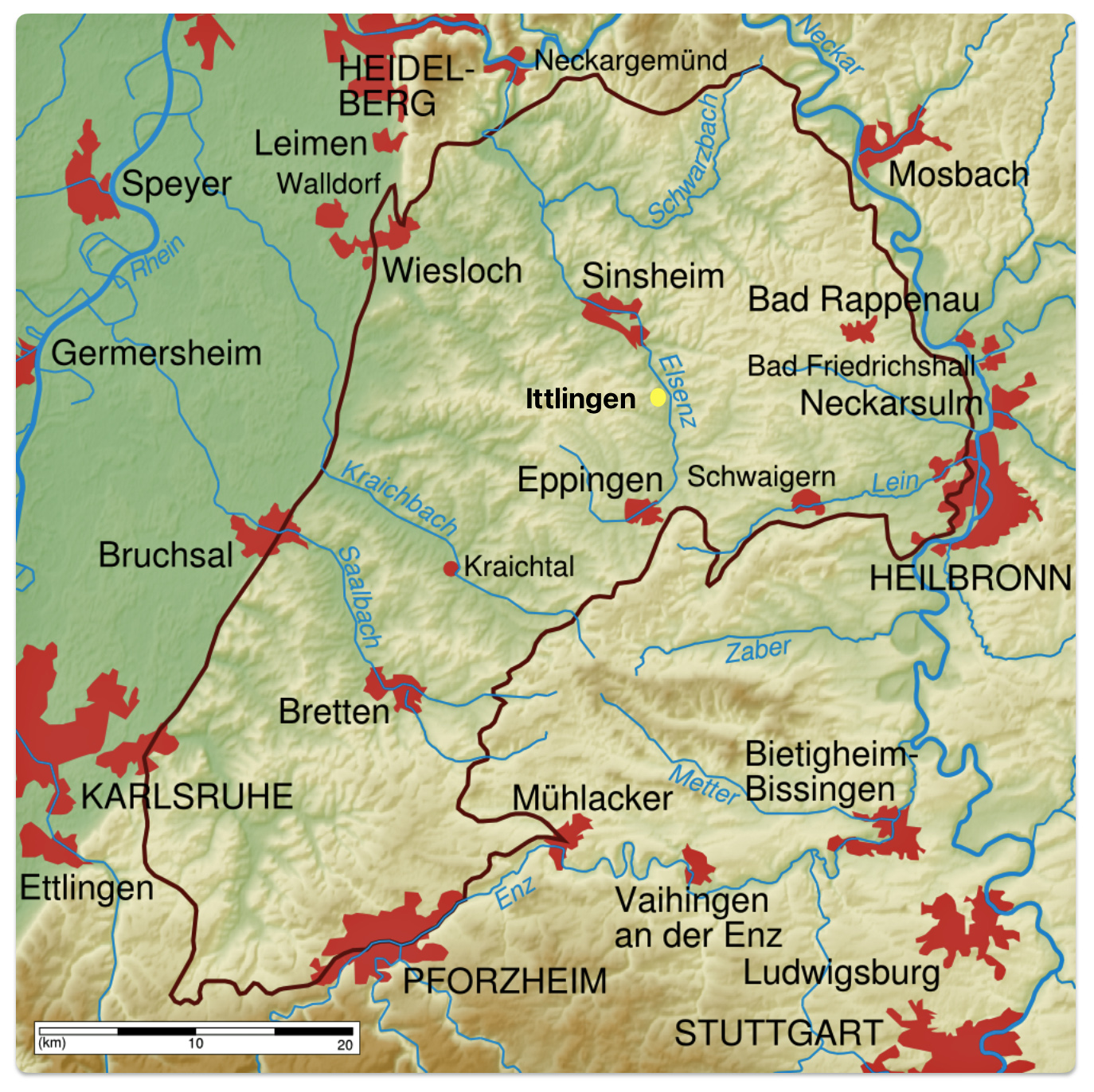This is part two of a story that focuses on the possible historical influences on German immigration from the Baden area in the mid 1800s. The second part of the story discusses the following influences:
- Travel Agents & Brokers: the influence of travel agents on facilitating travel; and
- Travel literature: the information contained in emigration maps, newspaper, and books as a reflection of accumulated knowledge of migration.
It is not known if John Speber or the Fliegel family used Travel agents or brokers or travel literature to plan their journeys to America. It is likely that they used brokers to secure passage on packet ships to New York.
As stated in the first part of this story, Germans from Baden, specifically in the geographical areas where John Sperber and the Fliegel family were from, had a long tradition of migrating to America. Their route getting to America was different from the Baden emigrants in the 1700s and early 1800s. However, there may have been a strong likelihood that they followed the guidance from past generations from their communities to settle in New York state. Even without specific contacts, they may had at least a general idea of settling in the ‘Palatine area’ of New York state. The use of travel agents or brokers may have been a means to make the journey happen.
As Competition Increased, Greater Enterprise Proved Needful
“The emigrant agent was not a new creation. In the previous century he had appeared as a traffiker in the souls, the Seelenverkaufer, who visited village after village on the upper Rhine and with his siren songs and promises filled Dutch ships with repdemptioners. In the nineteenth century he acted as the intermediary … . “ [1]
Midway through the eighteenth century, competition for the emigrant trade intensified. The role of a shipping agent became specialized and the migrant broker evolved as a new role and focused on utilizing various strategies to attract migrants. The contacts that informed the migrant brokers about the supply of migrants in the hinterland consisted primarily of boatmen working on the Rhine waterway system. The boatmen served as go-betweens on a commission basis. They were joined by an expanding network of inland agents who solicited migrants.
Another role that emerged was the “Newlander” (neuländer). The newlanders were former German emigrants who travelled back home and worked for American land speculators and employers who were aware of their ability to influence chain-migration patterns. [2]
There was a shift in the nature of German immigration with the demise of indentured servitude to America after 1819. Post 1819, German migrants now paid for their passage. Consequently, the cost of travel to the United States became a key determinator to emigrate. Cost also was a major factor concerning what port to embark and where to end up in America. Passenger transportation became an important branch of commerce and a source of competition among shipping companies and between major ports. [3]
“At first the scramble for passengers centered in the ports but as competition increased, greater enterprise proved needful.”[4]
With to the advent of packet ships, standardized ship schedules, and a shift to other ports starting in the in 1820s and 1830s, travel agents and brokers started playing a role in facilitating German immigration to the United States. Their role was notable when the overland and overseas journey from Europe was a longer, more arduous, and a multi-stage process. [5]
“The Atlantic migration on which these individuals now embarked … was conducted by different models and networks than in the previous century. German migrants now paid their passage … the majority departed from ports such as Le havre, Bremen, Liverpool, and latterly Hamburg.” [6]
Initially the captain of a ship negotiated passage on the voyage. Newspaper advertisements typically advised “Apply to the Captain on board“. By the 1830s, the role of a ship broker emerged. Initially the role amounted to being a ‘runner’ that brought passengers to the captain of a ship and received a commission for the number of passengers brought for transport. This role changed and expanded when the owner of a ship, which could have been the captain, sold the available passenger space for a flat sum to a recruiting house. [7]
“It was customary for the captain to lease to an emigrant agent the space reserved for passengers, and to assume no responsibility himself for their comfort and well-being.” [8]
The Role of Travel Agents
The role of travel agents in the German immigration to the United States was multifaceted and evolved, reflecting broader changes in transportation, regulation, and the nature of migration itself.
In the early stages of German immigration, particularly during the nineteenth century, travel agents, also known as “Makler” in Germany and “runners” in the United States, played a role in facilitating the journey of German emigrants to America. These agents were part of a larger network of individuals and organizations that helped emigrants navigate the complexities of international travel, from their departure in German ports to their arrival and settlement in the United States. [9]
Travel agents played several facilitating roles in German immigration to the United States in the 1830s through 1850s:
- Facilitating Travel: As a primary role, travel agents and companies provided services that helped immigrants navigate the logistics of transatlantic travel, which included arranging passage on ships and providing information on the travel process. [10]
- Promotion and Information: Travel agents and emigrant aid companies actively promoted travel to the United States through advertisements, pamphlets, guidebooks, and newspapers designed for emigrants. They distributed materials that highlighted the benefits of emigration and provided practical advice for the journey. [11]
- Political Influence: In specific geographical areas and contexts, German immigrants were specifically recruited. For example, German immigrants were specifically recruited by the state Wisconsin in the 1850s, . Another example is the Mainzer Adelsverein at Biebrich am Rhein, better known as the Mainzer Adelsverein (“Nobility Society of Mainz”) which was a colonial attempt to establish a new German settlement within the borders of Texas. Recruitment advertisements and publications were written and used to appeal to German immigrants, as exemplied by the writing of Eduard Pelz, reflecting the political motivations behind encouraging certain groups to emigrate to certain areas. [12]
- Protecting Immigrants: Some organizations, like the Deutsche Gesellschaft von New Orleans, were initially established to protect German immigrants from false agents and travel brokers. They also provided advice on avoiding disease and helped immigrants make arrangements to settle in “healthy” areas, away from regions prone to yellow fever. Benevolent organizations were formed in Philadelphia, New York City, Boston, and Galveston during the early to mid 1800s. They maintained employment agencies for common laborers, furnished credit to establish artisans in their trade, provided services for women, procured legal advice, provided aid to German immigrants in port cities, and medical aid. [13]
The Influence of Travel Brokers and Travel Agents in the 1840’s and 1850’s
It has been argued that the ‘push’ factors of the local and regional German economy and social structural factors of the local communities and the ‘pull’ factors of economic opportunity and information from family and friends contained in emigrant letters were the more decisive for formulating decisions to emigrate than the influence of travel brokers or travel agents. Combined with local knowledge of past migratory practices and correspondence from family or community members living in America, the use of travel brokers possibly helped emigrants with the completing the details of journey that was already planned. [14]
The agent’s or broker’s role was, for practical purposes, limited to facilitating the travel. They guaranteed that the price of a ticket would not increase while the emigrant was traveling to the port. They also assured space on board as well as setting any unplanned events associated with irregular sailing schedules. If travel agents or travel brokers had any influence, it may have been convincing migrants to leave from a particular port and consequently increasing the use of a particular port.
“(A)gents should be seen as mediators and facilitators, who eased the process of emigration. But they could do little to promote it where a predisposition did not already exist or a firm decision to emigrate had not already been made.” [15]
As competition for European emigrants increased between the European ports, individual companies, cities and states implemented regulations and practices to garner an edge or a larger share of emigrants to their respective ports. At first the scramble for passengers centered on the ports but as competition increased, travel agents utilized by the shipping companies and the respective city governments gained more prominence.
“By 1846-7, a network of fast interior travel routes, and an abundance of embarkation ports – all with agents vying for emigrant cargo – were in place. Agents were no longer unscrupulous figures known by previous generations; in Baden, Württemberg and Hessen, they were licensed, bonded and kept under surveillance, with contracts legally obligated to guarantee that passengers would reach their stipulated destination at the agreed price.” [16]
“Agents appear somewhat more frequently in immigrant letters than do guidebooks or emigration societies, but primarily as facilitators, not as promoters of emigration. Potential followers were often advised as to the dependability of a particular agent. Negative experiences were just as readily reported as positive ones.” [17]
The reliability and assurances in the advertising or travel brokers and agents were corroborated or questioned as German immigrants wrote back to relatives and friends in Germany.
“As immigration increased in volume, passenger transportation became a more important branch of the shipping business between Europe and America, and rivalry among the ship-owners grew keen. It was necessary for them to advertise abroad through publications and traveling agents not only the free institutions and bounties of nature in America, but also the special facilities they offered for crossing the ocean. Meantime it grew easier to detect misrepresentation. The postal service became better and cheaper on both sides of the Atlantic, and other means of communication were improved. In consequence the ill-usage or discomfort of passengers on certain ships became known to prospective emigrants, and the reputation and profits of the owners suffered. ” [18]
The Port of Le Havre and Travel Brokers
Due to it increased dominance in international commerce and transportation of emigrants, Le Havre experienced rapid and dramatic population growth during the mid-nineteenth century. A city of fewer than 27,000 inhabitants in 1823, it doubled in size by 1846. It was a port city of extreme wealth and poverty. [19]
“As in Paris, the sudden pressure exerted by this growth on the city’s physical and social structures caused considerable anxiety among political leaders. The concentration of so many people in the close quarters of the central city—especially working people confronting the contradictions of dire poverty in the midst of great mercantile and industrial wealth—gave a troubling immediacy to the prospect of disease and unrest; on the heels of two cholera epidemics and two revolutions in France during the 1830s and 1840s, few could ignore the threat posed by the nation’s increasingly pathological cities. A perceived penchant for drink and depravity among the “dangerous classes” only exacerbated the fears of local and national elites.” [20]
The following advertisement reflects the practices of immigrant agents from Havre. The advertisement indicates that emigrants are accompanied to Havre by licensed agents, suggesting travel agents were meeting prospective emigrants outside of Havre. Fair warning was also given to prospective emigrants about verifying their good standing.
1855 Advertisement – Parket Ship Service from Le Havre

Translation of the Advertisement
The port began to function as an emigration port at the end of the Napoleonic wars around 1815. Boarding passengers was a by-product of commercial shipments. As ship travel gained importance not only for commercial commerce but also for immigration, the docks at Le Havre were enlarged to accommodate the increased steamboat traffic from local ports. A German colony of innkeepers, shopkeepers and brokers subsequently developed to service the emigrant needs at the port. [21]
“The combined influence of the cotton and emigrant trade drew to it not only representatives of the larger commercial houses, but also a host of German innkeepers, small merchants and ship agents. The emigrants themselves sometimes went no further. … Every season left some to live upon the charity of the French, or to find a way back to their former home.” [22]
Given the impact of large groups of emigrants waiting for departing boats on the local infrastructure of the city and to avert having indigent emigrants showing up in the city, travel agents from Le Havre began meeting emigrants on the road from Strasbourg to sign them up in advance for passage to facilitate the emigration process. After 1837, when the French government required Germans to present a valid ticket at the border, local offices opened in Switzerland and the German states to facilitate this process. [23]
A French researcher points out the influence of Le Havre travel agencies located in Wissembourg, France and Forach, Baden on facilitating German immigration travel from Havre. (The following is a rough translation from French).
“(T)he Germans from regions close to the French border embark in Le Havre due to the ease of communication and the presence of Le Havre agencies in Wissembourg or Forbach. The distribution between nationalities may vary, but the region of recruitment of Le Havre in the broad sense remains the same: Germany of the South, in particular the regions close to the French border was easy. The Badens were the most numerous in 1856 and the years following, while the number of Bavarians, the most important previous years, tends to decrease.” [24]
Map One: Proximity of Havre Travel Agencies to Baden–Baden [25]
Map one is a depiction of Baden in 1846. As such it shows major roads, rail lines and waterways that existed in the mid 1840s. The above mentioned Havre travel agent locations were on water tributaries. They may have been minor roads that mirrored the tributaries that led to Baden-Baden where John Sperber lived. The map indicates the location of Weissenburg (or Weissenbourg) and Forbach (in the map it is noted as ‘Forb’. The distance between Weissenburg and Baden is about 50 kilometers or 31 miles. The distance between Baden and Forbach is about 20 kilometers or about 19 miles.
Travel Agents and the Hanseatic Cities of Bremen and Hamburg
In the late 1830’s, the city of Bremen “caused the employment of several hundred local representatives. Not only did these agents attend to the mechanics of emigration, but they stimulated the movement to their own private gain, printing letters in the newspapers, distributing circulars and conversing in the public houses and market places.” [26]
German emigres utilizing the port of Liverpool via Hamburg were assisted by German speaking travel agents. The “Hull Route” to America, involved immigrants departing from Hamburg, Germany to Hull, England and then departing from Liverpool. The route purportedly offered a saving in time and money. “At Hamburg, (travel) agencies sold the necessary tickets, and at Hull German guides who spoke English met the parties and conducted them across the island to the waiting sips at Liverpool.” [27]
The migrant became the commodity around which the shipping industry developed. Aware of the geographic disadvantages, the merchant community made a great effort to establish networks of migrant agents to divert the flow to Bremen. [28]
The following poster 1851 poster from the Bremen Information and Referral Agency provides information on accommodations, licenses forwarded or brokers, information on prices and debarkation ports and contact information to report complaints about unsatisfactory treatment. [29]
Poster of the Bremen Information and Referral Agency, 1851
A rough translation for the top portion of the poster: Notice for protection and care for Emigrants staying in Bremen, officially confirmed by the Senate Protection Bureau
The German governments, notably the Hanseatic city-states of Hamburg and Bremen, understood the importance of travel agents but also developed protective measures on behalf of emigrants through the supervision of travel and the licensing of agents. Certain practices, such as the sale of ‘through tickets’ into the interior of the United States were prohibited. The cities demanded a substantial bond payment as a guarantee against default of providing available slots for travel. [30]
“To wean migrants from the established Rhine route, one of the broker-officials in 1831 founded an agency in Frankfurt to (1) sell tickets for the trip from the place of origin to the American port of debarkation, (2) organize the trip to Bremen, (3) guarantee a berth on a ship-which were usually not yet departing in regularly scheduled line traffic. By 1832, about a dozen such agencies operated in central and southern Germany, with subagents in smaller places and with assistants along the route to Bremen who helped the emigrants along.” [31]
In 1854, several Bremen agencies in south-eastern Germany organized a joint “travel agency” in Cologne which took care of the migrants’ trip from the home villages along the Rhine and inland tributaries to Bremen. [32]
The public and private sectors in the city of Bremen worked together to establish protective measures for the emigrant and an environment to facilitate private initiatives to stimulate and profit from emigration.
“After 1850 for the accommodation of emigrants passing through she (Bremen) maintained a bureau of information; and special agents appointed by the city authorities met the incoming trains at the railway stations, guided them to hotels that had been inspected and licensed to receive them, protected them against extortion, and gave them aid and advice in preparing for the voyage. All these measures were quickly adopted by Hamburg, and some of them appeared in the passenger acts of Holland in 1837, of Belgium in 1843, and of France in 1855.” [33]
Literacy and Education in the Duchy of Baden and German States
It is not known what education levels John Sperber and the Fliegel family members attained when they were growing up in Baden. It is also not known what impact, if any, information gleaned from local newspapers and advertisements had on their plans to immigrate to America. It is assumed that they had a minimum of four years or more years of education and, thus, were able to read available newspapers and literature on America. They were from small villages or towns in central and northern Baden.
We can place our relatives from Baden Germany in an historical context with regard to literacy levels in the Grand Duchy of Baden and other German confederation states at the time of their life prior to emigrating. An historical understanding of the state of newspapers in the Grand Duchy of Baden can also provide sense of the relative importance and possible influence newspapers and newspaper advertisements may have had on emigration.
In the last third of the nineteenth century Germans became a “paper-reading people.” [34] While this observation references the reading habits of Germans after John Sperber and the members of the Fliegel family had emigrated from Baden, the education levels and literacy rates of common Germans in the nineteenth century were quite high, especially compared to other European countries at the time.
From 1450 to 1550, literacy rates in Germany climbed from 7 percent to around 16 percent. Over the next century the number of literate adults doubled in Germany, and remained at this level until the early nineteenth century. From 1820 onwards, literacy rates incrementally increased to 99%. [35]
By 1850, Prussia’s literacy rate had reached 85%, which was representative of the rest of the German states. This compares to a mid-century literacy rate of 61% for France (reading only) and 52% for England (reading and writing). [36]
In the early nineteenth century, Baden was among the first German states to introduce free and generally compulsory primary education, consisting of an eight-year course called Volksschule (elementary school). This provided basic skills like reading, writing, and arithmetic, along with a strict education in ethics, discipline and obedience to the state. In 1810, Baden introduced state certification requirements for teachers, which significantly raised the standard of teaching. [37]
It is notable that an organizational edict was issued in Baden in 1803 to reorganize and standardize the states’s educational system. The edict made elementary schooling compulsory and promoted academic freedom at the university level. It was part of Baden’s state-building efforts after Baden’s territorial expansion. [38]
Key points about the “Thirteenth and Last Organizational Edict of May 1803” are:
- It aimed to organize the common and scientific educational establishments in Baden’s newly united territories, considering the variety of existing institutions in the geographical area and the addition of Heidelberg University.
- The edict divided schools into rural and urban elementary schools. Rural schools were to provide basic Christian and civic knowledge to students without distracting them from their occupational work. “(C)lasses are held early enough for the older children so that
a good part of the day remains during which they can help their parents with domestic work.” - It mandated permanent year-round schools rather than just winter schools, so children would not forget their learning over the summer.
- School attendance was compulsory from ages 7 to 13 for girls and 14 for boys, with punishments for willful absences. School supervisors were required to “punish the children if their willfulness is to blame or the parents if they have given cause to the children for this conduct. Punishment of the former involves moderate beating, of the latter, sentencing to minor fines, either from 12 to a maximum of 60 kreuzers to the local alms, or by imprisonment in the village hall for a duration of four to 24 hours.”
- Subjects of instruction in rural elementary schools must be: spelling, reading, writing of the German language, arithmetic, singing, Bible history, materials of religious instruction, “(among which we count primarily that which must be committed to memory.)”
- In addition to the basic elementary school, it was instructed that ‘finishing schools’ that existing in various regions of the country should be standardized.
- The edict standardized various named higher level schools and their curriculum that existed in different areas of Baden under the rubric of Lycei schools.
- The edict was seen as a departure from the medieval tradition of education as a tool of the state. Instead, it promoted the modern concept of freedom in research and instruction. [39] [Click for PDF Copy]
“(G)irls and boys attended elementary school together, and the high literacy rate suggests that schools were well attended. Textbooks for schools in Baden during the late nineteenth century offered extensive information on the geography, population, and life in the United States to a broad readership of young Badeners.” [40]
Baden was part of the German states that saw literacy rates substantially higher than other parts of Europe by the mid-nineteenth century. The literacy gap between the Netherlands and West Germany ranged from 70% in 1600 to 15% in 1800, with West German towns catching up to Dutch literacy rates by the 18th century. [41] The combination of early compulsory education laws, cultural emphasis on literacy in the German states, and development of school infrastructure likely drove Baden’s high literacy rate compared to other regions by 1850.
The expansion of compulsory primary schooling mirrored the rise in literacy rates in Baden. Literacy rates rose dramatically, from around 80% in the early 1800s to near universal literacy by 1900.
“By the 1840s Baden had achieved a recognized statehood, not only among the powers of Europe, but more importantly among its own citizens. Economic development, an expanded educational system, the stirring of free trade and the state financing of railroads are, along with a vital constitutional system and political life, the most important indications of state-building. Other signs that diverse societies were merging into one unity of state and society include a literature of atlases, travelogues, handbooks, and newspapers intended for a Baden audience.” [42]
Newspapers in Germany in the 1830s – 1850s
Most of the newspapers in the German states in this time period catered to localized regions within their respective state boundaries. There were a few notable German newspapers that had a following in other states and European countries. In addition, there were a few influential newspapers from France and other countries that were read in the German states.
“In 1830, the main British and French daily newspapers, such as the Times and the Moniteur, were read throughout Europe, after their distribution network had spread through large parts of the continent in the 18th century. To a lesser extent, the most influential German-language daily, the Allgemeine Zeitung of the Tübingen publisher Johann Friedrich Cotta established in 1798, also had a European readership. … In addition to full-time editors, the most influential newspapers also engaged a dense network of journalists and correspondents, who sent in regular news and reports.” [43]
There existed about 100 political newspapers in Germany before 1848. German political and social realities were not favorable to the growth of a modern press in the first half of the 1800s. The political fragmentation among 39 German states impacted communication and transportation. This had implications on the development, range, and impact of German newspapers on their potential audience. The backwardness of the postal system in the German confederacy between 1830 – 1850 had not yet been incorporated into the Prussian-led customs union, the Zollverein. This made the distribution of a newspaper a financially prohibitive venture. [44]
“For instance, in 1840 the Seebliitter (a newspaper in Konstanz, Baden) cost 1 Gulden 30 Kreuzer biannually in Konstanz, but 2 Gulden 20 Kreuzer anywhere else in Baden. Its price doubled upon entry into a neighboring state, and cost increases of 500 to 600 percent were not uncommon when several state borders had to be crossed. If a certain newspaper staff aspired to conquer a national market, it had to gear its product to the wealthy class of Germans … . ” [45]
Coupled with the challenges of the cost and ability to create a circulation base wider than a city or local region, there was the effects of Vorzensur during this time period on what was published in German newspapers. Vorzensur is the German term for “prior restraint” or “pre-censorship”. It refers to ‘censorship imposed, usually by a government or institution, on expression before publication or distribution, prohibiting particular instances of expression‘. [46]. Vorzensur (pre-publication censorship) existed in the German Confederation during the Vormärz period in the early-to-mid 1800s, a period that John Sperber and the Fliegel family lived in the Grand Duchy of Baden. [47]
“The publishers owed their existence to the sale of their papers; and what sold then, as what sells today, were those papers that pleased the public. They saw no advantage in jeopardizing a sure thing by opting for two unpredictables: the financial uncertain ties of enlarging a market and the challenge of censor ship.” [48]
It was a time of growing social and political tensions after the Congress of Vienna in 1815 re-established the old monarchical order with new state governance structure in the German Confederation. The period was characterized by political conflict between ‘restorationist forces’ led by primarily by Austria, one of the two ‘powerhouse’ states in the confederation (the other being Prussia), and liberal nationalist movements within many of the medium-sized states (like the Duchy of Baden) and smaller states of the confederation. Political factions in the latter mentioned group wanted a unified German nation-state with a constitution and individual rights.
To suppress liberal and nationalist sentiments, Metternich, the leader from the dominant confederation state of Austria, instituted the repressive Carlsbad Decrees in 1819, establishing strict censorship and surveillance. Despite this, liberal and nationalist ideas continued to spread, especially among the rising educated middle class (Bürgertum), student fraternities (Burschenschaften), cultural societies, and the rising professional class of state bureaucrats.
“The ambivalence toward Vormarz censorship was nowhere more apparent than in Baden, which at that particular time was the constitutionally most advanced state in Germany. Freedom of the press being an expected pillar of a democratically oriented government, the Badensean authorities found themselves in a dilemma trying to reconcile the demands of the Iiberals for freedom of the press with the controls over it expected by the Bund (German Confederation – Deutscher Bund). Its press legislation, as well as its censorship enforcement, reflected this situation.” [49]
“For instance, the state of Baden silenced the dangerous Deutsche Volkshalle of Konstanz, which in 1840 already pursued a strictly republican tendency, by having the Konstanz post office confiscate a whole series of issues within the span of two months.” [50]
Emigration Advertising and Newspapers
Within the strictures of Vorzensur [51] , German-language newspapers both in Germany and the United States played a role in the mid-1800s in spreading information about emigration opportunities, providing practical advice to emigrants, and helping maintain connections and identity within German immigrant communities. [52]
“The average German of that time was content in thinking no further than the limits of his township. This parochial view clearly influenced the content and the format of the majority of papers … . “ [53]
Various advertisements in German newspapers and in books gave information about where to stay in specific continental ports, the cost of staying in the ports while waiting for outgoing ships, the costs of travel from major ports to America, and how to survive cheaply before setting sail. Newspaper and books also provided personal experiences from German immigrants who settled in America.
One notable example of the influence of newspaper reporting on the German emigrant experience in the mid 1800s is the German newspaper Allgemeine Auswanderungs-Zeitung. It was printed by the Rudolstadt publisher Günther Fröbel between 1846 and 1871, during times of high demand for emigration information. A major distinction of this newspaper was its sole focus on German emigration and related subjects, .
The newspaper aimed to inform readers about the realities of emigration and life abroad. Not only did it provide descriptive facts and costs associated with travel, it kept readers abreast of emigration-related news and debates. The newspaper included passenger lists and information for emigrants from 1848-1869. It reprinted articles from other papers like the American German newspaper Anzeiger des Westens [54] about emigrant experiences. The paper reported on controversial issues such as the return migration experiences to Germany in the mid-1800s. [55]
Masthead of Allgemeine Auswanderungs-Zeitung [56]
“ln Germany, in 1846, Günther Fröbel, a printer, publisher. and emigration agent, began publishing one of the main emigration newspapers, the Allgemeine Auswanderungs-Zeitung ( AAZ: General Emigration Newpaper). Though he published this newspaper out of the city of Rudolstadl, an interior city located in the current German state of Thuringia, roughly 250 kilometers east of Frankfurt. Fröbel was known as a well-informed emigrant agent. Throughout iitsi 26 years of circulation. the AAZ provided advice, lists of ships that were traveling overseas, articles on emigrants’ experiences, information on what to expect at different destinations, and reporting on all sorts of regions around the world in which Germans were settling. Regular readers of this newspaper were primarily people involved in the business, of migration including agents, shipping. brokers, business people, and government authorities.” [57]
Bremen, one of the ‘big three’ ports of departure in the 1840s- 1850s also had a major newspaper that principally reported on emigration and immigration matters in the mid 1800s – the Deutsche Auswanderer-Seitung (German Emigrant Newspaper). The Deutsche Auswanderer-Zeitung was founded in 1852 by Carl Schünemann, a Bremen publisher and bookseller. Schünemann recognized the need for a newspaper that could provide reliable information and advice for the many Germans considering emigration in the mid-19th century. He used his publishing house, C. Schünemann Verlag, to print and distribute the weekly newspaper.
The Deutsche Auswanderer-Zeitung was primarily read by Germans who were considering or planning emigration, particularly to the United States, during the mid-19th century. While the exact circulation figures are not readily available, the newspaper’s longevity (1852-1875) suggests that it had a significant and stable readership during its years of publication.
The “Deutsche Auswanderer-Zeitung” was published weekly. This frequency allowed it to provide timely and relevant information to its readers, who were primarily individuals and families planning to emigrate or already in the process of emigrating. The weekly publication schedule helped keep the German emigrant community well-informed about the latest news, legal changes, and opportunities available in their new homelands. [58]
Masthead of the Deutsche Auswanderer-Seitung [59]
“Reading through … emigration newspapers is a bit like bearing witness to the development of an expanding business and activity, namely the transportation of people east to west and/or south. In 1846, the first year of publication, regular and consistent passenger service from the European continent was still not quite established, and the AAZ (AAZ stands for Allgemeine Zeitung) newspaper explained that captains needed to fill their empty ships with passengers. By 1847, there were many ads showing that regular service had been established. In 1850, there was a noticeable uptick in the number of advertisements announcing regularly scheduled sailings between Europe and the United States. At this point, there were also more ads claiming passage on “fast” sailing ships, presumably trying to compete with the new steamships. Over the 1850s, more and more ads were placed regarding passage on steamships. By 1855, advertisements for fares on sailing ships dropped off and the paper no longer printed a fare table.” [60]
German Books and Auswander Publications
German newspapers and books circulated letters from German immigrants, describing their experiences and the prospects in America. Books were also published that provided descriptions of American life and opportunities.
Traugott Bromme’s “Handbook and Travel Book for Emigrants” [61]
Guidebooks specifically for German emigrants, such as Traugott Bromme’s “Handbook and Travel Book for Emigrants”, initially published in 1840, and appeared in several editions between 1840 and 1866 were popular. [62]
“The 1848 edition contains over 550 pages divided into two main parts. In the first part, Bromme offered a general overview of the United States, including thumbnail sketches of most of the states, territories, or countries that an emigrant might enter in North America.” [63]
In 1842, Bromme published a two-volume set Gemälde von Nord-Amerika (Portrait of North America) intended as both a travel guide and “entertaining instruction”. [64]
“Traugott Bromme sought to further German immigration to the United States both as a public advocate and as an entrepreneurial author and book seller. Realizing that there was a market for guides that German immigrants could use to help orient themselves in their adopted land, he leveraged the first-hand knowledge that he had acquired living and traveling throughout North America, and his general knowledge of the region acquired through other sources, to provide a valuable service to Germans … .” [65]
An earlier book that was popular was an 1829 book by Gottfried Duden. Duden had an influence on German immigration to the United States, particularly to the state of Missouri, in the early-to-mid 19th century. His famous 1829 book, “Report on a Journey to the Western States of North America” (German: “Bericht über eine Reise nach den westlichen Staaten Nordamerikas“), provided idyllic descriptions of the Missouri River valley that inspired tens of thousands of Germans to immigrate to the region. [66]
Duden visited Missouri from 1824-1827, purchasing a farm near present-day Dutzow. His letters to his home in Germany covered topics like slavery, Native Americans, farming methods, and weather. His positive depiction of Missouri, comparing it to the Rhine River valley, made the region very appealing to Germans.
His book was widely read in Germany and went through multiple editions. It reached all parts of Germany and Switzerland. The engaging first-hand account made his experiences seem believable and relatable to Germans facing hardships at home.
Friedrich Gerstiick
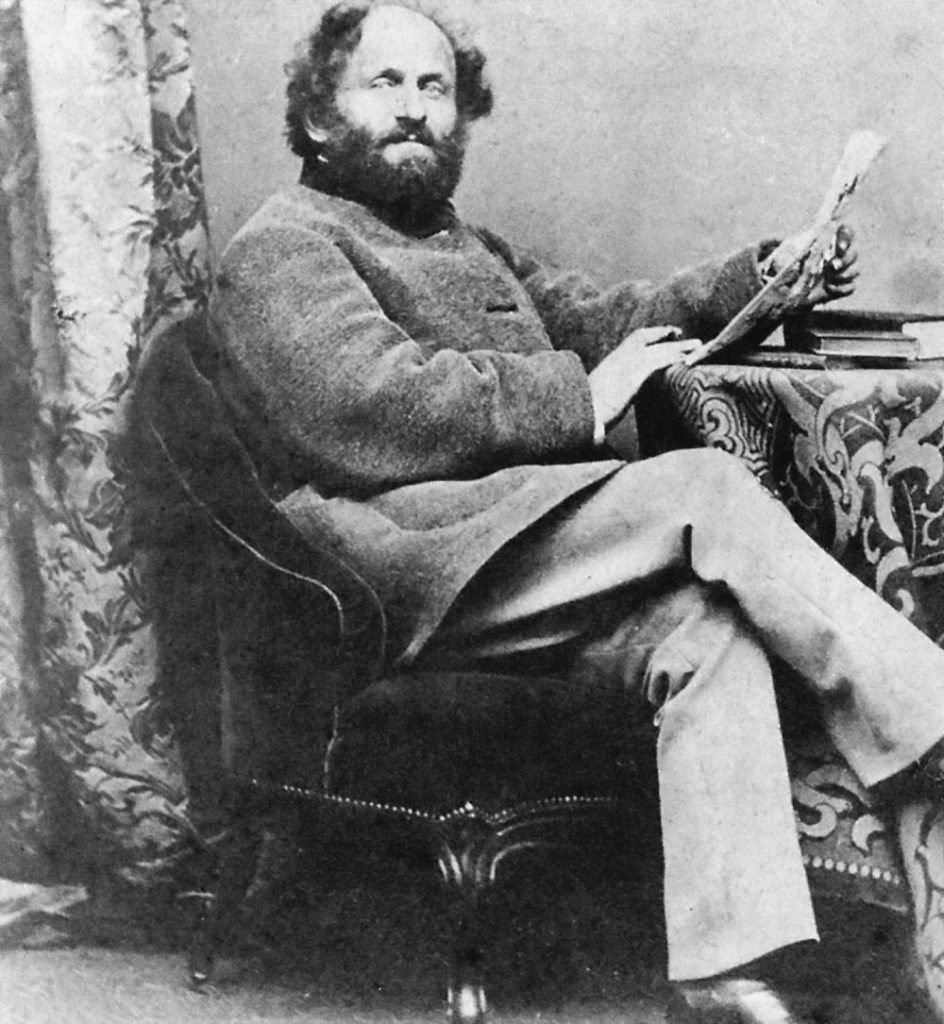
Friedrich Gerstiick, a German traveler, novelist, and adventurer, also wrote about America. Just under 21, he wandered through most of the United States, working as fireman on a steamboat, deck hand, farmer, silversmith, merchant, a hunter and trapper in the Indian territory, and worked at a hotel in Louisiana. Gerstick returned to Germany six years later in 1843. [68]
“To his great surprise, he found himself famous as an author. His mother had shown his diary, which he regularly sent home, and which contained descriptions of his adventures in the New World, to the editor of the Rosen, who published them in that periodical. These sketches having found favour with the public, Gerstäcker issued them in 1844 under the title Streif- und Jagdzüge durch die Vereinigten Staaten von Nordamerika (Forays and hunting expeditions through the United States of North America).” [69]
His handbook Wie ist es denn nun eigentlich in Amerika? (What Is It Really Like in America?), was published in 1849, the year after the fifth edition of Bromme’s book. Gerstacker, having lived in Arkansas, wrote stories about the state. [70]
Popular German travel books and novels were a source of information about America for many Germans. These works often portrayed America as a land of opportunity with abundant jobs, land, freedom and food – everything Germany was perceived to lack. Many books also provided descriptions of states and regions of the United States as well as suggestions for where to relocate.
The Influence of German Press and Publications on Immigration
The relative impact of publications in the various German states on encouraging and shaping German immigration to the United States in the nineteenth century is not entirely known. As previously stated, as competition increased between shipping lines and ports of embarkation for a portion of the increasing immigration market, it was necessary for them to advertise through publications and traveling agents.
“(I)t is surely also true that every one of them (citizens in Baden) actually had a certain knowledge about “America” or the “United States” in a broad and diffuse sense before they headed off on their journey. This knowledge was based on digesting masses of information on the overseas country from a multitude of sources: books and newspapers, journals and magazines, travel guides and novels, letters and talks, but also, of course, hearsay. All of these information sources shaped what contemporaries knew about “America,” how they planned their journey, and how they began to acculturate and to integrate into the new social, political, economic, cultural, and environmental contexts.” [71]
Given the history of emigration patterns in the Grand Duchy of Baden since the eighteen century and coupled with the social and cultural characteristics of Baden as a German state, emigration literature was available and accessible to citizens who were able to read and were interested in reading about America.
“Besides data on fares, the German newspapers contained a wide variety of other information for potential emigrants. (Information was provided) on the cost of getting to an embarkation port by steamship and railroad. Similarly, potential emigrants were given information on travel options in their destination countries, especially the United States. Advice on maintaining personal safety in getting the port, on the ships, and in the United States was provided. Specific groups, such as unaccompanied women, potential farmers, and those wishing to settle in California after the gold rush began, were given guidance as well. The papers also contained ads for many immigrant advice books for a variety of destinations illl both North and South America. In sum, the German newspapers covered not only fares but other aspects of the immigrant experience.” [72]
The city government of Bremen and local businesses were aggressive in marketing the benefits of utilizing the port for emigration.
“In an advertising campaign in south German newspapers, an innovation at that time, they (the city government of Bremen and local businesses) extolled the advantages of travel via Bremen/Bremerhaven. [73]
“If there was a time when emigration guidebooks and propaganda did have an appreciable influence on emigration, it was at the outset of the movement. The first time that emigration from Germany surpassed the ten thousand mark was 1832. Since food prices were stable at that time and real wages rising slightly, one should perhaps look beyond the economic realm.” [74]
As the use of travel agents and advertising grew, poor service and misrepresentation or travel services became noticed. Poor service, the discomfort of emigrant passengers, and the reputation of specific ships or packet ship lines became known to prospective emigrants. ‘Enlightened self-interest’ led to improvements in services.
“The Germans have a proverb, “Lies have short legs” and this is particularly true in the case of emigration propaganda. Chain migration provided a vigilant control mechanism. If advertisements were not true, they were only effective for one season; thereafter, letters to friends and relatives would set things straight.” [75]
Sources
Feature banner: An amalgam of (1) an 1846 Map of Baden: Radefeld, Carl Christian Franz,, Gross Herzogthum Baden. Na(c)h den bessten Quellen entw. u. gez. vom Hauptm. Radefeld. 1846. Stich, Druk und Verlag des Bibliographischen Instituts zu Hildburghausen, (1860) Page 38 (see below);
(2) a translated French quote from Braunstein, Jean, L’émigration allemande par le port du Havre au XIXe siècle, Page 102, https://www.persee.fr/doc/annor_0003-4134_1984_num_34_1_6382 and
(3) and advertisement of an travel agent from Havre with travel fares to New York, found at Mark Rosen, Le Havre as emigration port, Genealogisch-historischer Service, http://www.genhist.org/ghs_Havre_eng.htm .
The yelow circles identify the two locations of Havre travel agents that were close to Baden-Baden, the area where John Sperber lived in the Baden-Baden area – identified with a blue circle. The blue lines indicate possible routes that John Speber started his journey to the port of Le Havre, France.
[1] Marcus Lee .Hansen, The Atlantic Migration 1607-1860. Cambridge, MA: Harvard University Press, 1961, Page 196
[2] See the following for an overview of the German migration as an internatinal system and the changing and diverse roles of brokers:
Feys, Torsten, ‘The Role of Middlemen’, The Battle for the Migrants: Introduction of Steamshipping on the North Atlantic and Its Impact on the European Exodus (Liverpool, 2012; online edn, Liverpool Scholarship Online, 24 Jan. 2019), P 11- 15, https://doi.org/10.5949/liverpool/9781927869000.003.0002,
[3] Cohn, Raymond L., and Simone A. Wegge. “Overseas Passenger Fares and Emigration from Germany in the Mid-Nineteenth Century.” Social Science History, vol. 41, no. 3, 2017, pp. 393–413. JSTOR, https://www.jstor.org/stable/90017919
Boyd, James D., Merchants of Migration: Keeping the German Atlantic Connected in America’s Early National Period, Immigrant Entrepreneurship 1720 to the Present, https://www.immigrantentrepreneurship.org/entries/merchants-of-migration-keeping-the-german-atlantic-connected-in-americas-early-national-period/
Boyd, James. “The Rhine Exodus of 1816/1817 within the Developing German Atlantic World.” The Historical Journal, vol. 59, no. 1, 2016, pp. 99–123. JSTOR, http://www.jstor.org/stable/24809839. Accessed 6 May 2024.
[4] Marcus Lee .Hansen, The Atlantic Migration 1607-1860. Cambridge, MA: Harvard University Press, 1961, Page 197
[5] Drew Keeling, Brokers and Entrepreneurs in Business of Migration Travel, Business Migration since 1815, Immigration Entrepreneurship 1720 to the Present, Aug 22 2018, https://www.immigrantentrepreneurship.org/entries/the-business-of-migration-since-1815/#Brokers_and_Entrepreneurs_in_the_Business_of_Migrant_Travel
Feys, Torsten, ‘The Role of Middlemen’, The Battle for the Migrants: Introduction of Steamshipping on the North Atlantic and Its Impact on the European Exodus (Liverpool, 2012; online edn, Liverpool Scholarship Online, 24 Jan. 2019), P 14, https://doi.org/10.5949/liverpool/9781927869000.003.0002,
[6] Boyd, James. “The Rhine Exodus of 1816/1817 within the Developing German Atlantic World.” The Historical Journal, vol. 59, no. 1, 2016, pp. 105. JSTOR, http://www.jstor.org/stable/24809839
[7] Marcus Lee .Hansen, The Atlantic Migration 1607-1860. Cambridge, MA: Harvard University Press, 1961, Pages 196 – 197
[8] Page, Thomas W. “The Transportation of Immigrants and Reception Arrangements in the Nineteenth Century.” Journal of Political Economy, vol. 19, no. 9, 1911, pp. 738. JSTOR, http://www.jstor.org/stable/1820349
[9] Hoerder, Dirk. “The Traffic of Emigration via Bremen/Bremerhaven: Merchants’ Interests, Protective Legislation, and Migrants’ Experiences.” Journal of American Ethnic History, vol. 13, no. 1, 1993, pp. 75. JSTOR, http://www.jstor.org/stable/27501115
Hansen, Marcus Lee, The Atlantic Migration 1607-1860. Cambridge, MA: Harvard University Press, 1961, Pages 88, 185, 116-117, 134, 155, 194, 198, 283, 255, 290, 292-293,
Feys, Torsten, ‘The Role of Middlemen’, The Battle for the Migrants: Introduction of Steamshipping on the North Atlantic and Its Impact on the European Exodus (Liverpool, 2012; online edn, Liverpool Scholarship Online, 24 Jan. 2019), https://doi.org/10.5949/liverpool/9781927869000.003.0002,
[10] James D. Boyd, An Investigation into the Structural Causes of German-American Mass Migration in the Nineteenth Century, Submitted for the award of PhD, History, Cardiff University 2013, Page 124 – 125
Page, Thomas W. “The Transportation of Immigrants and Reception Arrangements in the Nineteenth Century.” Journal of Political Economy, vol. 19, no. 9, 1911, pp. 738. JSTOR, http://www.jstor.org/stable/1820349
Kamphoefner, Walter D. “Immigrant Epistolary and Epistemology: On the Motivators and Mentality of Nineteenth-Century German Immigrants.” Journal of American Ethnic History, vol. 28, no. 3, 2009, Page 43 JSTOR, http://www.jstor.org/stable/40543427
Cohn, Raymond L., and Simone A. Wegge. “Overseas Passenger Fares and Emigration from Germany in the Mid-Nineteenth Century.” Social Science History, vol. 41, no. 3, 2017, pp. 393–413. JSTOR, https://www.jstor.org/stable/90017919
Hansen, Marcus Lee, The Atlantic Migration 1607-1860. Cambridge, MA: Harvard University Press, 1961, Page 194-198229, 255, 283, 286, 290, 292-293
Schrader, Tina Marie, 19th Century German Immigration to America: Paul Müller’s Search For a Better Way of Life, Honors Thesis 5 -1990, Carbondale: Southern Illinois University, 1990, https://opensiuc.lib.siu.edu/cgi/viewcontent.cgi?article=1288&context=uhp_theses
[11] Cohn, Raymond L., and Simone A. Wegge. “Overseas Passenger Fares and Emigration from Germany in the Mid-Nineteenth Century.” Social Science History, vol. 41, no. 3, 2017, p. 397. JSTOR, https://www.jstor.org/stable/90017919
Hansen, Marcus Lee, The Atlantic Migration 1607-1860. Cambridge, MA: Harvard University Press, 1961, Page 194-198229, 255, 283, 286, 290, 292-293
[12] Strohschänk, Johannes & William G. Thiel, The Wisconsin Office of emigration 1852 – 1855 & its Impact on German Immigration to the State, Maz Kade Institute for German-American Studies, Madison: University of Wisconsin, 2005 https://search.library.wisc.edu/digital/AVQEJV32INHGXI82/pages?view=scroll
Promoting Paradise: The Recruitment of Volga German Immigrants to the American Midwest, 1870-1900, Master of Arts History, Las Vegas, University of Nevada, Las Vegas, 2020, https://digitalscholarship.unlv.edu/cgi/viewcontent.cgi?article=5490&context=thesesdissertations
Inge Auerbach, Inge, “Auswanderung aus Kurhessen 1832-1866,” Hessische Blatter fier Volks-und Kulturforschung, Neue Folge (new series), 17 (1985)
Weiss, Jana and Jana Weiss, “‘On to Texas’: An Introduction to the Miniseries on Texas Germans,” Migrant Knowledge, April 4, 2024, https://migrantknowledge.org/2024/04/04/on-to-texas-an-introduction-to-the-miniseries-on-texas-germans/.
Adelsverein, Wikipedia, This page was last edited on 2 December 2023, https://en.wikipedia.org/wiki/Adelsverein
Brister, Louis, Adelsverein, , August 25, 2018, Texas State Historical Association, https://www.tshaonline.org/handbook/entries/adelsverein
Johnson, Hildegard Binder. “Eduard Pelz and German Emigration.” Minnesota History, vol. 31, no. 4, 1950, pp. 222–30. JSTOR, http://www.jstor.org/stable/20175560
Rippley, La Vern J., Official Action by Wisconsin to Recruit Emigrants 1850 – 1890, Yearbook of German-American Studies (YGAS) Volume 18, 1893 , pp 185 – 196, Official Action by Wisconsin to Recruit Immigrants, 1850-1890Journals@KUhttps://journals.ku.edu › ygas › article › download
Page, Thomas W. “The Transportation of Immigrants and Reception Arrangements in the Nineteenth Century.” Journal of Political Economy, vol. 19, no. 9, 1911, pp. 745–746. JSTOR, http://www.jstor.org/stable/1820349
[13] 19th Century Immigration, Benevolent Organizations, and Churches, The Historic New Orleans Collection, https://www.hnoc.org/research/19th-century-immigration-benevolent-organizations-and-churches
Page, Thomas W. “The Transportation of Immigrants and Reception Arrangements in the Nineteenth Century.” Journal of Political Economy, vol. 19, no. 9, 1911, pp. 744 – 746. JSTOR, http://www.jstor.org/stable/1820349
[14] Page, Thomas W. “The Transportation of Immigrants and Reception Arrangements in the Nineteenth Century.” Journal of Political Economy, vol. 19, no. 9, 1911, pp. 738. JSTOR, http://www.jstor.org/stable/1820349
Kamphoefner, Walter D., The Westfalians: From Germany to Missouri, Princeton, NJ: Princeton University Press 1987, Page 58
[15] Kamphoefner, Walter D., German Emigration Research, North, South, and East: Findings, Methods, and Open questions, Pages 28 in Dirk Hoerder and Jörg Nadler, (ed) People on Transit German Migrations in Comparative Perspective 1820 – 1930, Cambridge: Cambridge University Press, 1995
[16] James D. Boyd, An Investigation into the Structural Causes of German-American Mass Migration in the Nineteenth Century, Submitted for the award of PhD, History, Cardiff University 2013, Page 124 – 125 https://orca.cardiff.ac.uk/id/eprint/47612/1/2013boydjdphd.pdf
Walker, Mack, Germany and the Emigration, 1816-1885 (Cambridge, MA, 1964 p.87
[17] Kamphoefner, Walter D. “Immigrant Epistolary and Epistemology: On the Motivators and Mentality of Nineteenth-Century German Immigrants.” Journal of American Ethnic History, vol. 28, no. 3, 2009, Page 43 . JSTOR, http://www.jstor.org/stable/40543427
[18] Page, Thomas W. “The Transportation of Immigrants and Reception Arrangements in the Nineteenth Century.” Journal of Political Economy, vol. 19, no. 9, 1911, pp. 743. JSTOR, http://www.jstor.org/stable/1820349 .
[19] Barnes, David S., The Making of a Social Disease: Tuberculosis in Nineteenth-Century France. Berkeley: University of California Press, c1995 1995. http://ark.cdlib.org/ark:/13030/ft8t1nb5rp/. Chapter 6: Le Havre, Tuberculosis Capital of the Nineteenth Century
[20] Ibid, The Making of a Social Disease, Chapter 6
[21] Marcus Lee Hansen, The Atlantic Migration 1607 – 1860. Cambridge, Massachusettes: Harvard University Press, 1941, Page 186 – 187
Seaports – Sea Captains, The Maritime Heritage Project – San Francisco 1846 – 1899, Home Port, France: La Havre https://www.maritimeheritage.org/ports/France-Le-Havre.html
January 10, 1871, Daily Alta California, San Francisco, California
[22] Hansen, Marcus Lee, The Atlantic Migration 1607 – 1860. Cambridge, Massachusettes: Harvard University Press, 1941, Page 187
[23] Hansen, Marcus Lee, The Atlantic Migration 1607 – 1860. Cambridge, Massachusettes: Harvard University Press, 1941, Page 198
[24] “(L)les Allemands des regions proches de la frontiere franaise s’embarquent au Havre du fait des facilites de communication et de la presence d’agences havraises a Wissembourg ou Forbach. La repartition entre nationalites peut varier, mais la region de recrutement du Havre au sens large reste la meme : I’ Allemagne du Sud, en particulier les regions proches de la frontiere franaise. Les Badois sont les plus nombreux en 1856 et les annees suivantes, alors que le nombre des Bavarois, le plus important les annees precedentes, tend a diminuer.”
Braunstein, Jean, L’émigration allemande par le port du Havre au XIXe siècle, Table: Emigrants Allemands Embarques Au Havre (1830 – 1870), Annales de Normandie, 1984, Page 102, https://www.persee.fr/doc/annor_0003-4134_1984_num_34_1_6382
[25] Meyer, Joseph, Gross Herzogthum Baden. Na(c)h den bessten Quellen entw. u. gez. vom Hauptm. Radefeld. 1846. Page 36. Stich, Druk und Verlag des Bibliographischen Instituts zu Hildburghausen, (1860),David Rumsey Map Collection Cartography Associates, https://www.davidrumsey.com/luna/servlet/detail/RUMSEY~8~1~21866~680022:Gross-Herzogthum-Baden—Na-c-h-den# or https://www.davidrumsey.com/luna/servlet/workspace/handleMediaPlayer?qvq=&trs=&mi=&lunaMediaId=RUMSEY~8~1~21866~680022
[26] Hansen, The Atlantic Migration 1607-1860, Page 198
[27] Hansen, The Atlantic Migration 1607-1860, Page 194
[28] Feys, Torsten, ‘The Role of Middlemen’, The Battle for the Migrants: Introduction of Steamshipping on the North Atlantic and Its Impact on the European Exodus (Liverpool, 2012; online edn, Liverpool Scholarship Online, 24 Jan. 2019), P 18, https://doi.org/10.5949/liverpool/9781927869000.003.0002,
[29] Hoerder, Dirk. “The Traffic of Emigration via Bremen/Bremerhaven: Merchants’ Interests, Protective Legislation, and Migrants’ Experiences.” Journal of American Ethnic History, vol. 13, no. 1, 1993, pp. 79. JSTOR, http://www.jstor.org/stable/27501115 .
[30] Hansen, The Atlantic Migration 1607-1860, Page 290
[31] Hoerder, Dirk. “The Traffic of Emigration via Bremen/Bremerhaven: Merchants’ Interests, Protective Legislation, and Migrants’ Experiences.” Journal of American Ethnic History, vol. 13, no. 1, 1993, pp. 74. JSTOR, http://www.jstor.org/stable/27501115 .
[32] Hoerder, Dirk. Page. 75.
also Mack Walker, Germany and the Emigration, 1816-1885 (Cambridge, MA, 1964 p.87;
[33] Page, Thomas W. “The Transportation of Immigrants and Reception Arrangements in the Nineteenth Century.” Journal of Political Economy, vol. 19, no. 9, 1911, pp. 742. JSTOR, http://www.jstor.org/stable/1820349 .
[34] Nipperdey, Thomas, Deutsche Geschichte 1866–1918, vol. 1 (Munich: C.H. Beck, 1994), 797; quoted in Martin Bemmann, “The Latest News from the Other Side: ‘America’ in the Freiburger Zeitung of 1876,” Migrant Knowledge, November 18, 2022, https://migrantknowledge.org/2022/11/18/america-in-the-freiburger-zeitung/
[35] Calder, Natalie, Literacy and Print in early and Modern Germany and England, Medieval Forum, August 19, 2015, https://blogs.qub.ac.uk/medievalforum/2015/08/19/literacy-and-print-in-early-modern-germany-and-england/
Houston, Robert A., Nov 28, 2011, posted Feb 18, 2018, The Growth of Literacy in Wester Europe from 1500 to 1800, Brewminate, https://brewminate.com/the-growth-of-literacy-in-western-europe-from-1500-to-1800/
[36] Gawthrop, R.L. , Literacy Drives in Preindustrial Germany. In: Arnove, R.F., Graff, H.J. (eds) National Literacy Campaigns. Springer, Boston, MA. 1987 https://doi.org/10.1007/978-1-4899-0505-5_2
[37] Education in Germany, Wikipedia, This page was last edited on 11 May 2024, https://en.wikipedia.org/wiki/Education_in_Germany
Germany: History & Background, https://education.stateuniversity.com/pages/518/Germany-HISTORY-BACKGROUND.html
[38] The Thirteenth and Last Organizational Edict was issued by Margrave Karl Friedrich von Baden on May 13, 1803. This edict was part of a series of reforms to reorganize the educational system in Baden after it acquired new territories.
Source: Fink, Erwin, translation – Kurfürstlich Badische Landes-Organisation. In 13. Edicten sammt Beylagen, und Anhang [Land Organization of Electoral Baden. In 13 Edicts including Attachments and Appenix]. Karlsruhe: Macklot, 1803, pp. 1-8. Original Source is reprinted in : Walter Demel and Uwe Puschner, eds., Von der Französischen Revolution bis zum Wiener Kongreß 1789-1815 [From the French Revolution to the Congress of Vienna 1789-1815]. Deutsche Geschichte in Quellen und Darstellung, edited by Rainer A. Müller, vol. 6. Stuttgart: P. Reclam, 1995, pp. 349-62 https://ghdi.ghi-dc.org/pdf/eng/16_ScienceandEducation_Doc.2_ENGLISHxxxTRANS.pdf
[39] Selgert, Felix. Baden and the Modern State: The Implementation of Administrative and Legal Reforms in the German State of Baden during the 19th Century, Berlin, Boston: De Gruyter Oldenbourg, 2018. https://doi.org/10.1515/9783110602654
German mediatisation, Wikipedia, This page was last edited on 27 March 2024, https://en.wikipedia.org/wiki/German_mediatisation
Lee, Loyd E. “Liberal Constitutionalism as Administrative Reform: The Baden Constitution of 1818.” Central European History, vol. 8, no. 2, 1975, pp. 91–112. JSTOR, http://www.jstor.org/stable/4545736
Lee, Loyd E. “Baden between Revolutions: State-Building and Citizenship, 1800-1848.” Central European History, vol. 24, no. 3, 1991, pp. 248–67. JSTOR, http://www.jstor.org/stable/4546213
[40] Hoffman, Marie Nella , “A Cautionary Tale: Baden’s Late Nineteenth-Century Textbooks and Their Portrayal of America,” Migrant Knowledge, November 7, 2022, https://migrantknowledge.org/2022/11/07/baden-textbooks-portrayal-of-america/ .
[41] Calder, Natalie, Literacy and Print in early and Modern Germany and England, Medieval Forum, August 19, 2015, https://blogs.qub.ac.uk/medievalforum/2015/08/19/literacy-and-print-in-early-modern-germany-and-england/
[42] Lee, Loyd E. “Baden between Revolutions: State-Building and Citizenship, 1800-1848.” Central European History, vol. 24, no. 3, 1991, Page 226, . JSTOR, http://www.jstor.org/stable/4546213
See also:
Gray, Marion W. “‘Modifying the Traditional for the Good of the Whole’: Commentary on State-Building and Bureaucracy in Nassau, Baden, and Saxony in the Early Nineteenth Century.” Central European History, vol. 24, no. 3, 1991, pp. 293–303. JSTOR, http://www.jstor.org/stable/4546215
Lee, Loyd E. “Baden between Revolutions: State-Building and Citizenship, 1800-1848.” Central European History, vol. 24, no. 3, 1991, pp. 248–67. JSTOR, http://www.jstor.org/stable/4546213
Loyd E. Lee, The Politics of Harmony: Civil Service, Liberalism, and Social Reform in Baden, 1800-1850 (Newark : University of Delaware Press, 1980), https://archive.org/details/politicsofharmon0000leel/page/n5/mode/2up
[43] Julia A. Schmidt-Funke: The Revolution of 1830 as a European Media Event, in: European History Online (EGO), published by the Leibniz Institute of European History (IEG), Mainz 2017-08-16. URL: https://www.ieg-ego.eu/schmidtfunkej-2011-en URN: urn:nbn:de:0159-2017073107 [2024-05-02]. ▲10
[44] Fetscher, Elmar B. “Censorship and the Editorial: Baden’s New Press Law of 1840 and the ‘Seeblätter’ at Konstanz.” German Studies Review, vol. 3, no. 3, 1980, pp. 377–94. JSTOR, https://doi.org/10.2307/1429162. Accessed 11 May 2024.
[45] Ibid, Page 379
[46] Prior restraint, Wikipedia, This page was last edited on 28 March 2024, https://en.wikipedia.org/wiki/Prior_restraint
Vorzensur, German Vocabulary from 1600 to Today, DWDS, https://www.dwds.de/wb/Vorzensur
[47] Vorzensur (pre-publication censorship) existed in the German Confederation during the Vormärz period in the early-to-mid 1800s. particularly after the Carlsbad Decrees of 1819. The Vormärz period refers to the era in German history between 1815 (or 1830) and the March Revolution of 1848.
The July Revolution of 1830 in France and other uprisings reignited these movements in Germany, leading to some concessions by German rulers in the early 1830s. However, the monarchs then intensified reactionary measures, while opposition to the status quo kept growing. The tensions and resentments built up during the Vormärz era ultimately erupted in the revolutions of March 1848, as people across Germany demanded national unity, constitutions and civil liberties.
German Confederation, Wikipedia, This page was last edited on 13 April 2024, https://en.wikipedia.org/wiki/German_Confederation
States of the German Confederation, This page was last edited on 10 April 2024, https://en.wikipedia.org/wiki/States_of_the_German_Confederation
The German unification and freedom movement (1800 – 1848), Deutscher Bundestag, https://www.bundestag.de/en/parliament/history/parliamentarism/1800_1848/1800_1848-200328
Winkler, Heinrich August, Sep 9, 2018, The Vormärz and Paulskirche parliamentary movement, Deutschland, https://www.deutschland.de/en/topic/politics/the-vormarz-and-paulskirche-parliamentary-movement
Trencsényi, Balázs, and others, ‘Political Visions of the Vormärz’, A History of Modern Political Thought in East Central Europe: Volume I: Negotiating Modernity in the ‘Long Nineteenth Century’ (Oxford, 2016; online edn, Oxford Academic, 21 Apr. 2016), https://doi.org/10.1093/acprof:oso/9780198737148.003.0006
Jansson, A. (2020). Building or destroying community: the concept of Sittlichkeit in the political thought of Vormärz Germany. Global Intellectual History, 5(1), 86–103. https://doi.org/10.1080/23801883.2019.1586769
Henley, Andrew Dean, Vormätz of Germany and the Critique of Heinrich Heine, PhD Dissertation, Portland State University, Dec 10 1997, https://pdxscholar.library.pdx.edu/cgi/viewcontent.cgi?article=6444&context=open_access_etds
The German unification and freedom movement (1800 – 1848), Deutscher Bundestag, https://www.bundestag.de/en/parliament/history/parliamentarism/1800_1848/1800_1848-200328
[48] Fetscher, Elmar B. “Censorship and the Editorial: Baden’s New Press Law of 1840 and the ‘Seeblätter’ at Konstanz.” German Studies Review, vol. 3, no. 3, 1980, pp. 380. JSTOR, https://doi.org/10.2307/1429162 .
[49] Ibid, pp. 383.
[50] Ibid, pp. 379.
[51] Depending on the German state, writing about emigration could have been prohibited and subject to penalties. For example, in the Kingdom of Saxony there were “laws against emigration and against all who recommended it as a means to remedy the problems of the Fatherland.” Anyone who “enticed” Saxons to emigrate could be punished with up to ten years of incarceration
Bland, Richard L. Traugott Bromme, Feb 11, 2015, updated Aug 22, 2018, Immigrant Entrepreneurship, German Historical Institute, https://www.immigrantentrepreneurship.org/entries/traugott-bromme/
[52] Geitz, Henry, ed, The German American Press, Madison: Max Kade Institue for the German American Studies, 1992, https://search.library.wisc.edu/digital/AUALS5JMTUYL3J8Z/pages/AOYL64FTM2SFEZ8N?view=scroll
Grohsgal, Leah Weinryb, Chronicling America’s Historic German Newspapers and the Growth of the American Ethnic Press, July 2, 2014, National Endowment for the Humaities, https://www.neh.gov/divisions/preservation/featured-project/chronicling-americas-historic-german-newspapers-and-the-grow
Some of the major German newspapers that were published between 1840-1850 include:
- Altonaer Mercur – A newspaper published in Altona, Germany that is available in free online historical archives. Wikipedia:List of online newspaper archives, Wikipedia, https://en.wikipedia.org/wiki/Wikipedia:List_of_online_newspaper_archives#Germany
- Amberger Tagblatt and Amberger Volkzeitung – Two newspapers published in Amberg, Germany in the mid-1800s that are available in online historical archives. Historic German Newspapers Online, Euro Docs, https://eudocs.lib.byu.edu/index.php/Historic_German_Newspapers_Online
- Augspurgische Ordinari Postzeitung – A newspaper published in Augsburg, Germany from 1770-1806 that is available digitally through the Universitätsbibliothek Augsburg. See Historic German Newspapers Online, Euro Docs
- Berliner Gerichts-Zeitung – A Berlin newspaper with digitized issues available from 1853-1898 through the Staatsbibilothek zu Berlin. See Historic German Newspapers Online, Euro Docs
- Fränkisches Bürgerblatt and Neue Fränkische Zeitung – Two newspapers published in Würzburg in 1848-1850, available digitally through the Bayerische Staatsbibliothek.
- Illinois adler und Demokratischer Whig – A German-language newspaper published in Springfield, Illinois in 1844, held in the Library of Congress collections.
- Landeszeitung der Rheinprovinz – A newspaper published in the Rhine Province of Germany with some digitized issues from 1848-1850 available. Historic German Newspapers and Journals Online, Euro Docs, https://eudocs.lib.byu.edu/index.php/Historic_German_Newspapers_and_Journals_Online
While not an exhaustive list, these are examples of some major German newspapers from the 1840-1850 period, including both newspapers published within Germany as well as German-language papers in the United States, that have been digitized and made available through online historical newspaper archives.
[53] Fetscher, Elmar B. “Censorship and the Editorial: Baden’s New Press Law of 1840 and the ‘Seeblätter’ at Konstanz.” German Studies Review, vol. 3, no. 3, 1980, pp. 380. JSTOR, https://doi.org/10.2307/1429162
[54] Anzeiger des Westens, Wikipedia, This page was last edited on 15 January 2024, https://en.wikipedia.org/wiki/Anzeiger_des_Westens
[55] Moltmann, Günter. “American-German Return Migration in the Nineteenth and Early Twentieth Centuries.” Central European History, vol. 13, no. 4, 1980, pp. 378–92. JSTOR, http://www.jstor.org/stable/4545909
[56] Masthead is from Allgemeine Auswanderungs-Zeitung. Nr. 3. Rudolstadt, 13. Oktober 1846., Deutches Text Achiv DTA, https://www.deutschestextarchiv.de/book/view/nn_auswanderer03_1846?p=1
[57] Cohn, Raymond L., and Simone A. Wegge. “Overseas Passenger Fares and Emigration from Germany in the Mid-Nineteenth Century.” Social Science History, vol. 41, no. 3, 2017, pp. 395. JSTOR, https://www.jstor.org/stable/90017919
[58] Ibid, pp. 395.
[59] Masthead of the Deutsche Auswanderer-Seitung (German Emigrant Newspaper), Deutches Text Achiv DTA, https://www.deutschestextarchiv.de/book/view/nn_auswandererzeitung093_1852?p=1
[60] Cohn, Raymond L., and Simone A. Wegge. “Overseas Passenger Fares and Emigration from Germany in the Mid-Nineteenth Century.” Social Science History, vol. 41, no. 3, 2017, p. 397. JSTOR, https://www.jstor.org/stable/90017919
[61] Image from Past Auction of Traugott Bromme’s “Hand – Und Resebuch” Jan 25 2007, Freeman’s Hindman, https://www.freemansauction.com/auctions/fine-book-sale-1271/lot/292
[62] Traugott Bromme, Gemälde von Nord-Amerika in allen Beziehungen von der Entdeckung an bis auf die neueste Zeit—Eine pittoreske Geographie für Alle, welche unterhaltende Belehrung suchen und ein Umfassendes Reise-Handbuch für Jene, welche in diesem Lande wander wollen [Portrait of North America in All Connections from the Discovery to the Most Recent Time—A Picturesque Geography for Everyone Who Seeks Entertaining Instruction, and a Comprehensive Traveler’s Handbook for Anyone Who Wants to Travel in this Land] (Stuttgart, Germany, 1842).
Bland, Richard L., Traugott Bromme, Immigrant Entrepreneurship 1720 to the Present, Feb 11, 2015, updated Aug 22, 2018, German Historical Institute https://www.immigrantentrepreneurship.org/entries/traugott-bromme/
Bland, Richard L.. “Traugott Bromme and The State of Maine.” Maine Hist or y 49, 1 (2015): 102-112. https://digitalcommons.library.umaine.edu/mainehistoryjournal/vol49/iss1/5 or https://digitalcommons.library.umaine.edu/cgi/viewcontent.cgi?article=1126&context=mainehistoryjournal
Bland, Richard, and Traugott Bromme. “Translation of Traugott Bromme’s Handbook.” The Arkansas Historical Quarterly, vol. 55, no. 2, 1996, pp. 194–98. JSTOR, https://doi.org/10.2307/40030964
Bland, Richard L. “Notes and Documents: The State of Pennsylvania: As Seen by Traugott Bromme.” The Pennsylvania Magazine of History and Biography, vol. 127, no. 4, 2003, pp. 419–28. JSTOR, http://www.jstor.org/stable/20093659
Brister, Louis E. “The Image of Arkansas in the Early German Emigrant Guidebook: Notes on Immigration.” The Arkansas Historical Quarterly, vol. 36, no. 4, 1977, pp. 338–45. JSTOR, https://doi.org/10.2307/40020791
Bland, Richard. “‘A Noble-Minded, Honest People, Full of High Patriotism’: Traugott Bromme’s Observations on Kentucky and Kentuckians.” The Register of the Kentucky Historical Society, vol. 94, no. 1, 1996, pp. 59–66. JSTOR, http://www.jstor.org/stable/23383925
Bland, Richard L, “Traugott Bromme and the State of Louisiana”, Louisiana History: The Journal of the Louisiana Historical Association, vol. 53, no. 3, 2012, pp. 338–47. JSTOR, http://www.jstor.org/stable/23266746. Accessed 14 May 2024.
[63] Bland, Richard L., Traugott Bromme, Immigrant Entrepreneurship 1720 to the Present,Feb 11, 2015, updated Aug 22, 2018, German Historical Institute https://www.immigrantentrepreneurship.org/entries/traugott-bromme/
[64] Bland, Richard L., Traugott Bromme, Immigrant Entrepreneurship 1720 to the Present,Feb 11, 2015, updated Aug 22, 2018, German Historical Institute https://www.immigrantentrepreneurship.org/entries/traugott-bromme/
[65] Bland, Richard L., Traugott Bromme, Immigrant Entrepreneurship 1720 to the Present,Feb 11, 2015, updated Aug 22, 2018, German Historical Institute https://www.immigrantentrepreneurship.org/entries/traugott-bromme/
[66] Gottfried Duden, Wikipedia, This page was last edited on 2 April 2024, https://en.wikipedia.org/wiki/Gottfried_Duden
“Gottfried Duden: A Nineteenth-Century Missouri Promoter,” by James W. Goodrich, Missouri Historical Review LXXV, Jan, 1981, p 133
Gottfried Duden’s Report 1824-27″ Translated by William G. Bek, Missouri Historical Review XII, Oct, 1917, p 1-9
“Report on a Journey to the Western States of North America and a Stay of Several Years Along the Missouri (during the years 1824, ’25, ’26, and 1827),” 1829, English translation by Elsa Nagel, manuscript on file at the Western Historical Manuscript Collection–Columbia of the University of Missouri
Stadler, Ernst A. “The German Settlement of St. Louis .” Midcontinent American Studies Journal, vol. 6, no. 1, 1965, pp. 16–29. JSTOR, http://www.jstor.org/stable/40640533
[67] Portrait Photograph of Friedrich Gerstäcker, Wikimedia Commons, https://commons.wikimedia.org/wiki/File:Friedrich_Gerstäcker.jpg
[68] Friedrich Gerstäcker, Wikipedia, This page was last edited on 23 February 2024, https://en.wikipedia.org/wiki/Friedrich_Gerstäcker
Bland, Richard, and Traugott Bromme. “Translation of Traugott Bromme’s Handbook.” The Arkansas Historical Quarterly, vol. 55, no. 2, 1996, pp. 194–98. JSTOR, https://doi.org/10.2307/40030964
[69] Friedrich Gerstäcker, Wikipedia, This page was last edited on 23 February 2024, https://en.wikipedia.org/wiki/Friedrich_Gerstäcker
[70] Bland, Richard, and Traugott Bromme. “Translation of Traugott Bromme’s Handbook.” The Arkansas Historical Quarterly, vol. 55, no. 2, 1996, pp. 194–98. JSTOR, https://doi.org/10.2307/40030964
[71] Bemmann, Martin”, What Did They Know?: An Introduction to the Miniseries,” Migrant Knowledge, October 28, 2022, https://migrantknowledge.org/2022/10/28/intro-baden-migrants-miniseries/
[72] Cohn, Raymond L., and Simone A. Wegge. “Overseas Passenger Fares and Emigration from Germany in the Mid-Nineteenth Century.” Social Science History, vol. 41, no. 3, 2017, page 398. JSTOR, https://www.jstor.org/stable/90017919
[73] Hoerder, Dirk. “The Traffic of Emigration via Bremen/Bremerhaven: Merchants’ Interests, Protective Legislation, and Migrants’ Experiences.” Journal of American Ethnic History, vol. 13, no. 1, 1993, pp. 75. JSTOR, http://www.jstor.org/stable/27501115
[74] Kamphoefner, Walter D. “Immigrant Epistolary and Epistemology: On the Motivators and Mentality of Nineteenth-Century German Immigrants.” Journal of American Ethnic History, vol. 28, no. 3, 2009, Page 37-38 . JSTOR, http://www.jstor.org/stable/40543427.
[75] Kamphoefner, Walter D. “Immigrant Epistolary and Epistemology: On the Motivators and Mentality of Nineteenth-Century German Immigrants.” Journal of American Ethnic History, vol. 28, no. 3, 2009, Page 42 . JSTOR, http://www.jstor.org/stable/40543427




